Menus
- What you must remember
- Themore
- Theless
- Prices
- Make your2016 Honda CRF 250 R
- Opinion
- Replaces
- The technical aspect
- Competitors
- Gallery
- Related articles
The 2016 CRF 250 R claims a substantial gain in power at high revs thanks to the adoption of a new cylinder head, a new connecting rod and a new piston developed by the HRC. Low-end torque is also increased without loss of mid-range performance. The Showa SFF-TAC-Air oleopneumatic fork has been reworked to reduce internal friction and optimize its responsiveness and damping qualities. The rear shock absorber adopts new settings accordingly.
As nothing is ever taken for granted with regard to the MX2, the smallest evolutions can generate the biggest differences at the finish. It is for this reason that, for 2016, Honda applied to the engine and the suspensions of the CRF 250 R a whole range of improvements directly inspired by the experience acquired week after week by Team HRC on the machines engaged in MXGP..
The major evolution of the CRF 250 R 2016 revolves around the engine and more particularly a cylinder head, a connecting rod and a piston completely revised. The result is expressed in the form of additional power, much of it at high revs. A gain that is achieved without counterpart at low revs, without loss of sensitivity to the throttle grip and without altering the progressiveness of the arrival of this power..
At the same time, torque at low revs has been increased, as has the maximum power rpm. The exhaust manifold now has a resonator while the two silencers have their internal components redesigned. Finally, the air box has also been reworked to facilitate the flow of air..
On the cycle side, the Ø 49 mm Showa SFF-TAC-Air pneumatic fork also benefits from several internal evolutions as well as longer sleeves of 5 mm in their upper part in order to optimize grip, responsiveness and feedback. sensations and settings. The rear shock does not change but its settings are however tuned with the new characteristics of the front.
The other changes concern the reduction of the diameter of the final drive chain rollers and the installation of more easily “self-cleaning” footrests in the mud..
Motorization
The 249cc 4-valve Unicam single-cylinder of the 2016 CRF 250 R retains its core values of 76.8 x 53.8 mm with an output of 40 hp at 11,500 rpm (38 hp at 11,000 rpm in 2015 ) and a torque value of 27.1 Nm at 9,000 rpm (compared to 26.5 Nm at 8,500 rpm).
The 2016 unit thus proves to be more flexible and vigorous at low revs, retains its force at mid-revs and, as the revs increase, benefits from an increase in power and torque which remains stable until high in the engine. towers. A feature that prevents gear changes synonymous with wasting time in difficult passages.
The gain in power and torque – made without any consideration over the extent of the rev range – is to the credit of the important development work carried out by the HRC on the cylinder head. Work that began with the adoption of a new lighter piston, which conditions a compression ratio of 13.8 to 1 against 13.5 to 1 previously. This piston is associated with a connecting rod whose shape has also been revised and which contributes to the increase in power..
On the intake side, the air box receives an additional air intake while the length of the internal ducts has been changed. The cylinder head intake and exhaust ducts have been redesigned in accordance with information from the HRC while the Ø 25mm exhaust valves are now made of titanium rather than steel. The Ø 30.5 mm intake valves, already made of titanium, remain unchanged. The all-new camshaft acts on redesigned valve lifters, allowing higher lift for both intake and exhaust, while the material that makes up the intake valve spring is also new. The PGM-FI electronic double injection power supply with its Ø 46 mm body also has settings adapted to the new characteristics of the cylinder head.
The exhaust system uses a resonator installed between the engine and the manifold and which contributes to the ease of operation of the engine. In addition to larger diameter end caps and a new design of the internal baffles, the two silencers are also associated with new connection tubes..
The left radiator is larger to respond to the increased heat generated by the extra horsepower while the gearbox now uses a bearing-mounted selector barrel locking mechanism for better shifting feel. Finally, the diameter of the rollers of the final transmission chain has been reduced from 38 to 34 mm.
The EMSB (Engine Mode Select Button) command makes an already widely available engine even more accessible. This is an undeniable advantage for amateurs: rather than making adjustments during the week hoping that they will prove to be correct at the weekend, the pilot just has to stop, let the engine run. at idle speed and press the button for one second to select the engine map of your choice. Depending on the number of flashes observed on the light diode integrated into the handlebar control, the pilot can immediately know the mapping in progress. If a new map is selected, the choice is immediately confirmed by the same means.
In detail, Mode 1 uses a “standard” tuning between the ignition and injection curves in order to provide balanced power and torque characteristics. Mode 2 has been designed for low grip conditions – mud for example – and favors throttle control and fine feedback to allow the rider to make the most of the available grip. Finally, more particularly dedicated to sand, Mode 3 makes the engine more responsive and more aggressive in revs. Note that Modes 2 and 3 can be reprogrammed using the box as well as the software developed by the HRC.
Cycle part
The Ø 49 mm SFF-TAC-Air pneumatic fork has been specially developed by Showa for the CRF 250 R in order to be able to exploit the potential of the frame and gain more than one kg compared to a conventional inverted fork. The right arm of this fork controls the compression and rebound functions while the left arm compresses the air only in the compression phase. This arrangement allows perfect control of the left / right balance..
Three “cartridges” are arranged in the left arm to form an effective air spring. The “distribution” cartridge works from rest to low speeds, the “internal” cartridge is responsible for operating at mid-stroke while the “external” cartridge intervenes when the fork reaches the end of its stroke, before the stop.
The two fork arms claim the same travel and the same dimensions as the 2015 version. However, they have been thoroughly revised in order to reduce friction, optimize the reaction speed of the suspension but also the reaction force at mid-stroke, improving control during calls for jumps and landings.
The top tubes are 5mm higher above the top crown and to reduce internal friction (by approximately 25%) the construction, shape and number of internal air seals have been precisely refined. An additional air pressure of 80kPa has been added to the “external” chamber (against 0kPa previously) as well as a pneumatic valve allowing adjustments to be made. The other two cartridges (“internal” and “distribution”) now operate with an air pressure of 1075 kPa against respectively 1200 kPa and 1125 kPa previously. Finally, the range of damping settings goes from 4 to 8 notches.
At the rear, the Showa shock absorber is installed in the low position in the frame. To respond to the changes made to the front – and optimize rear wheel grip – its spring is stiffer on the first part of its travel. The rebound characteristics do not change but those of the compression phase have been increased from mid-stroke (compared to 2015) at the same time as the piston speed.
Fully adjustable, this shock absorber offers 17 possibilities of rebound adjustment while the compression is adjustable in 13 positions (low speeds) and 3.5 turns (high speeds). The Pro-Link system takes advantage of specific gear ratios and allows a travel of 317 mm. Thanks to a greater height in the center and in the front, the aluminum swingarm offers more rigidity, deforms less and improves the grip of the rear tire when exiting a corner..
The double beam aluminum frame of the CRF 250 R, of which it is now the 6th generation, does not change, as does the specific cradle that supports the engine. Designed from the outset in a spirit of mass centralization and to best match the characteristics of the Showa pneumatic fork, it announces a caster angle of 27’23 °, a drag of 117 mm and a wheelbase of 1,489 mm. The full weight is 105.6 kg.
The casing of the CRF 250 R also remains unchanged for 2016. It renews the principle that the machine is built above all to facilitate the movements and movements of the pilot. In other words, ergonomics is at the heart of the layout proposed by the CRF 250 R. Thus, the radiator scoops, the side covers, the ultralight saddle or the fuel tank have a continuity of shape which provides the pilot has significant freedom of movement and fluidity in his movements.
Subtle improvements to the footrests and their supports make locking them in the up position much more difficult when mud collects on them.
On the braking side, the Ø 260 mm “lace” front disc facilitates heat dissipation and improves the power generated by the action of the double piston caliper. The set is completed, at the rear, by a Ø 240 mm disc with a single piston caliper.
The aluminum rims are fitted with Dunlop MX52F / MX52 tires of 80 / 100-21 for the front and 100 / 90-19 for the rear.
Note that different maintenance kits will be available as an option for this 2016 vintage.
What you must remember
Themore
Theless
Prices
8 299 €
Price
nine
Compare
the credits
Make
your2016 Honda CRF 250 R
Estimate, calculate and compare the cost of insuring your motorcycle.
Calculate the cost of
insurance
Test the price of the motorcycle insurance specialist
Opinion
on 7 opinion
users
Read the reviews
Replaces
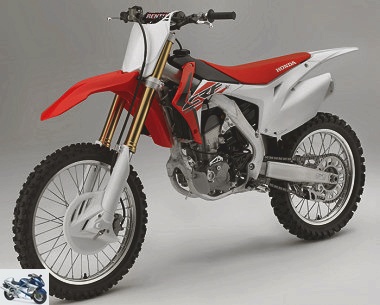
CRF 250 R 2015
Model marketed in
2012
2013
2014
2015
2016
2017
2018
2019
2020
The technical aspect
2016 Honda CRF 250 R
- Frame
- Frame: Double beam and single split aluminum cradle
- Tank: 6.3 liters
- Seat height: 951 mm
- Length: 2,181 mm
- Width: 827 mm
- Height: 1,271 mm
- Wheelbase: 1,489 mm
- Weight in running order: 105.6 kg
- Train before
- Telehydraulic inverted fork Ø 49 mm, deb: 310 mm
- 1 disc Ø 260 mm, 2 piston caliper
- Front wheel:
80/100
– 21
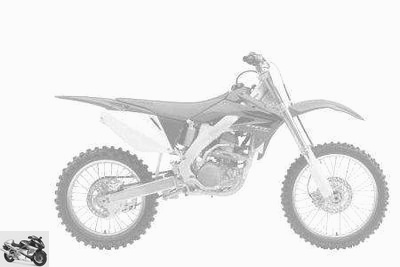
- Transmission
- 5-speed gearbox
- secondary by chain
- Rear axle
- Mono-shock, deb: 317.6 mm
- 1 disc Ø 240 mm, 1 piston caliper
- Rear wheel:
100/90
– 19
- Motor
- Single cylinder
in line
, 4 stroke - Cooling: by water
- Injection Ø nc
- 1 ACT
- 4 valves
-
249 cc
(76.8 x 53.8 mm) -
40
ch
at 11,500 rpm -
2.90 mkg
at 9000 rpm - Compression: 13.8: 1
- Crit’air:
Detached pieces
exhaust
motor
fluid
electricity
filtration
braking
chain kit
Competitors
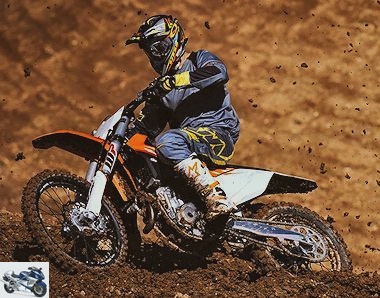
2016 KTM 250 SX-F
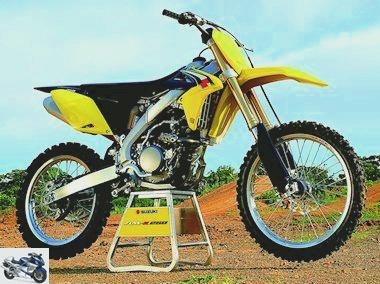
Suzuki RM-Z 250 2016

Yamaha YZ 250 F 2016
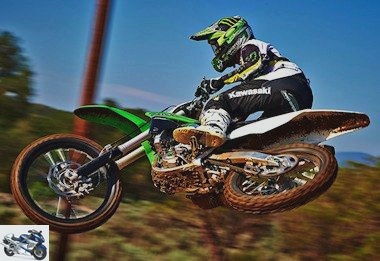
Kawasaki KX 250 F 2016
Gallery
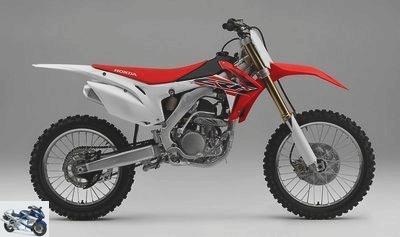
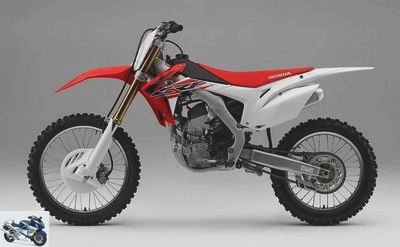
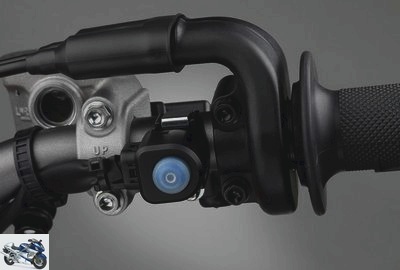
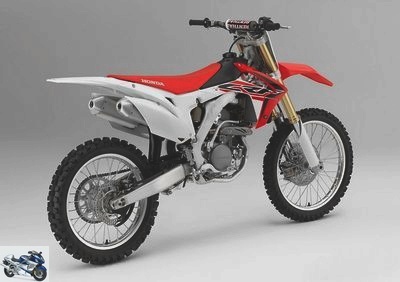

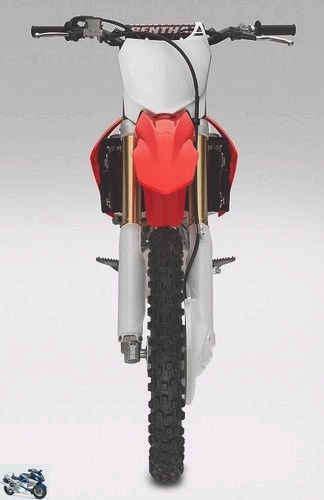
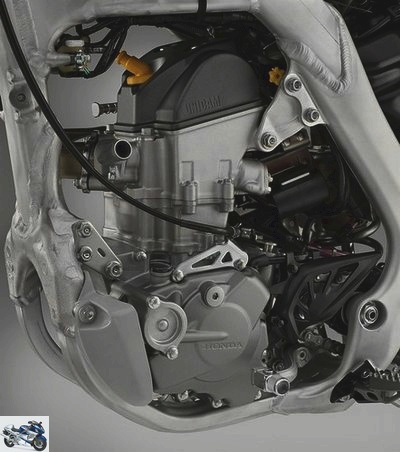
Related articles
-
Since 2016, the CRF 250 R has claimed a substantial gain in power at high revs thanks to the adoption of a new cylinder head, a new connecting rod and a…
-
Honda went all out to overhaul its CRF 450 R in 2017. A lot of work, the most important for 8 years, to make it a real combat machine. An engine derived…
-
It started with a breath coming from afar, where 4 perfect drops fell from a saber into the sea. From this rustling was going to be born a terror, a…
-
Combining since 2002 a benchmark chassis with an engine overflowing with power and torque, the CRF 450 R has demonstrated its winning potential to…
-
Honda did a hell of a job on their cross-country machine. Faced with very sharp competition, the 250 CRF had to evolve and the result is there: it…
-
The 2013 Honda CRF 250 R was a neat evolution of the previous model, the very one that won the two US Supercross Lites titles in 2012. For 2014,…
-
Kawasaki ZX-10R 1000 KRT Replica 2016
With the number of victories it has collected in WSBK, the ZX-10R can without restraint claim to be the ultimate mistress of the best drivers in the…
-
Honda went all out to redesign its CRF 450 R. A lot of work, the most important for 8 years, to make it a real combat machine. An engine derived from…
-
Yamaha SR 400 60th anniversary 2016
You have to have a certain faith and a lot of nostalgia, or a real crush to appropriate the SR 400. However, the approach is nice on the part of Yamaha:…
-
For its 2021 vintage, the Honda CRF 450 R benefits from a long list of improvements. To begin with, 2kg have been gained on the frame and the rear loop….